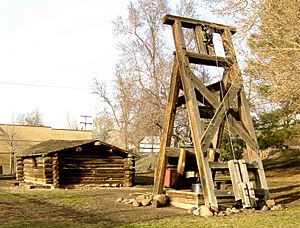Montana City, Colorado facts for kids
Montana City was the very first settlement in what is now Denver, Colorado. It was started in 1858 during the exciting Pikes Peak Gold Rush. This small town was built on the east bank of the South Platte River, close to where Little Dry Creek joins it. Back then, this area was part of the Kansas Territory.
People chose this spot because they thought there was a lot of gold nearby in the river. However, the gold found at Montana City wasn't much, so people quickly left. They moved a few miles downstream to a new settlement called Auraria. Today, the original Montana City site is part of Grant-Frontier Park. You can still see mining equipment and a replica of a log cabin there.
Contents
The Lawrence Party's Journey
In 1857, a butcher named John Easter, who lived in Lawrence, Kansas, heard exciting news. A man named Fall Leaf, from the Delaware tribe, told him about gold found near Pikes Peak. Fall Leaf had been a guide for soldiers and found gold during his travels. He even showed a sample to John Easter!
John Easter shared this news, and many people became interested in going to Colorado to find gold and new opportunities. This group was called the "Lawrence Party." It included about 48 people, with two women and one child. They left Lawrence, Kansas, in May or June of 1858. The group was led by J.H. Tierney, and they even had a surveyor to help plan a new town.
Traveling West
The Lawrence Party traveled from Kansas with eleven wagons. They followed the famous Santa Fe Trail and hunted buffalo for food. Along the way, one man got lost, but some Cheyenne men helped him find his way back to the group.
On June 28, they reached Bent’s Fort on the Arkansas River. After a short stop, they continued northwest along the Arkansas River. They then followed the Fountain River (near present-day Pueblo) to the Garden of the Gods area (now Colorado Springs). They camped there for about a month, from July to early August 1858.
Julia Archibald Holmes: A Pioneer Woman
Among the travelers were newlyweds Julia Archibald Holmes and James H. Holmes. Julia was a brave and independent woman. She was a friend of Susan B. Anthony, who fought for women's rights. Julia wore a special outfit with "bloomers" (baggy pants under a short skirt). This allowed her to walk and explore much more easily than long skirts would.
Julia was the first recorded European American woman to reach the top of Pikes Peak, which is over 14,000 feet high! She wrote about her adventures in letters to her mother and a newspaper. She described meeting Cheyenne and Arapaho people and her joy at reaching the mountain's summit.
Finding Montana City
After a month of searching for gold near Pikes Peak, the group decided to move on. They heard about gold found on the South Platte River at Dry Creek. This news caused the group to split up. Some went to Fort Garland for supplies, and others headed to Taos, New Mexico.
The rest of the Lawrence Party, still hoping to find gold and build a town, headed north. They built rows of cabins on the east side of the South Platte River. They called their new settlement "Montana City." The word "Montana" means "mountain" in a feminine form. They named the rows of cabins Leavenworth Row, Kansas Row, and Lawrence Row. These cabins were the first buildings in the Denver area.
The group even formed a company called the "Montana Town Company." John Easter was one of the men who built a cabin there. However, the South Platte River did not have much gold. Many of the remaining men from Kansas eventually went home. The cabins were taken apart and moved to the nearby settlement of Auraria.
Today, the abandoned Montana City site is Grant-Frontier Park in Denver. It's located on South Platte River Drive, southwest of Santa Fe Drive and W. Evans Avenue.
What Happened to Some Travelers?
- John Easter later moved to the Cripple Creek mining area, west of Colorado Springs.
- Julia Archibald Holmes and her husband, James, moved to New Mexico. Julia wrote for a newspaper, and James was appointed by President Abraham Lincoln to a government position. Later, Julia worked in Washington, D.C., and became the chief of a special division in the Bureau of Education.


